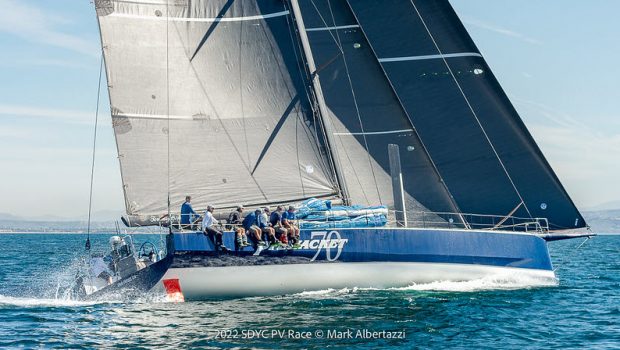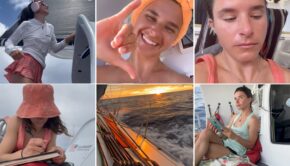Always something to see and experience
Published on March 15th, 2022
Compression occurred for the fleet competing in the 2022 San Diego to Vallarta International Yacht Race, rattling the rankings for the final 270nm sprint across the Sea of Cortez to the finish in Puerto Vallarta (click here for update). Onboard the modified Volvo 70 Pyewacket 70, navigator Peter Isler reminds how the journey remains the reward when offshore racing.
Ocean racing can open your eyes to a whole new world.
There’s the delights of trying to get your body onto a napping style sleep cycle that fits into the constraints of a watch system. Living in the humid, shall we say sometimes stagnant close quarters inside a hull with limited ventilation (to prevent the water rushing over the deck from coming in), can take some getting used to.
While the bunks may not provide the same level of support as their mattresses at home, there’s the delights of new sights, sounds, and experiences of being out in what feels like the middle of the ocean – and that part of the trip can be worth the ticket price.
It was the third day of our 1000 mile race from San Diego to Puerto Vallarta – 48 hours into the action – and we had been feeling pretty good about ourselves, enjoying moderate air running conditions that the turbo-charged Volvo 70 excels in. Triple head rigged, we were starting to count our chickens – all too early.
It was around mid-day when the wind faded to under 10 knots, shifted unfavorably to the west and the confused sea made for some very slow sailing. We hadn’t yet hit the area of the race track where that sort of light air conditions are expected (the Cabo lee), but some high clouds gave a bit of a clue to the disturbance in the force.
So with thoughts of glory fading as we watched on the AIS the fleet stormed up from behind, we moved our stack of sails forward (that racing rule constraining moving ballast and equipment is relaxed in most west coast offshore races) and moved the crew up onto the bow in the light air and newly hot sun.
It was then when the unexpected occurred. We were gabbing away on the bow, looking for signs of sea life is so abundant in this part of the ocean, when a whale appeared from underneath the bow – swimming at a perpendicular course to our heading. Deeper down, the crystal blue waters revealed a bigger version gliding underneath the whale that we could have easily climbed on top of for a ride if we’d acted quickly enough.
As we processed the unexpected sight, it became clear that a mother California Gray Whale had decided to teach her baby how to practice close quarters maneuvers using our carbon fiber race boat as a “pool toy”. Off they swam, the baby clearly proud to have followed mom’s instruction to keep its head down while ducking under the boat – and to miss all the things sticking out of its bottom.
Sailing up and down the California and Baja coast lines, whales are a common sight – and sometimes they come close, but I’ve never seen a mother and baby – swimming along as if the mom was carry the baby by piggyback at such a close range. There are some lagoons in Mexico where you can watch the mothers and babies at close range, but we got the show as a bonus to our race.
There’s always something new to see and experience out on the water – if you keep your eyes open.
Event information – Race details – Entry list – Tracking – March 15 roll call – Photos
Note: The tracking has a 4-hour delay.
Monohull Record: Bakewell White 100 Rio 100 set in 2016 at 03:05:42:43. Finishing by 18:02:42 on March 15 breaks the record.
Start schedule for 30 entrants:
March 10 – Division 6
March 11 – Division 3, 4, 5
March 12 – Division 1, 2
Source: SDYC









 We’ll keep your information safe.
We’ll keep your information safe.